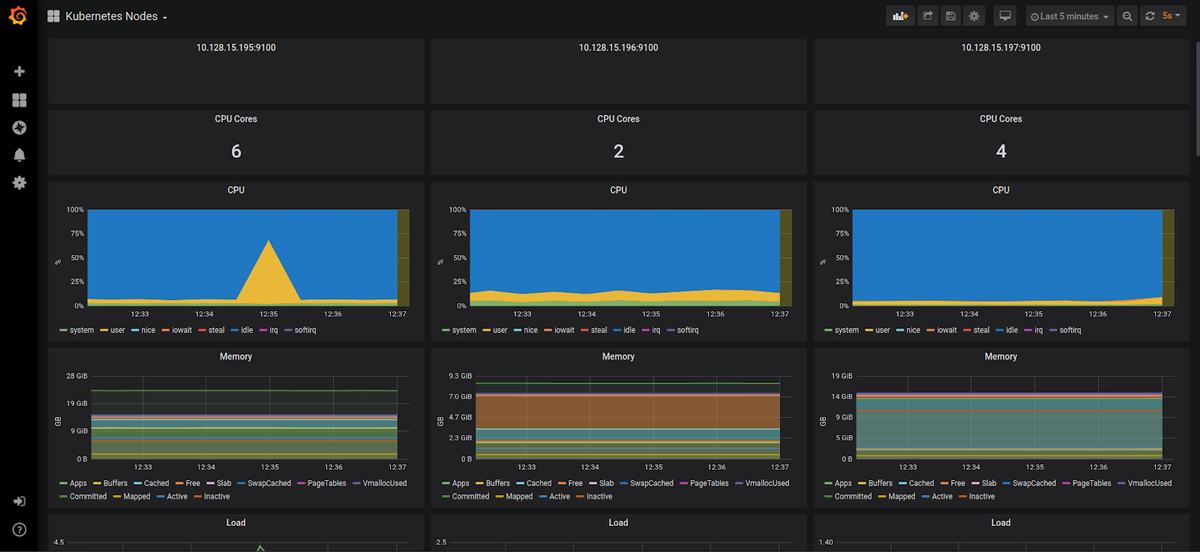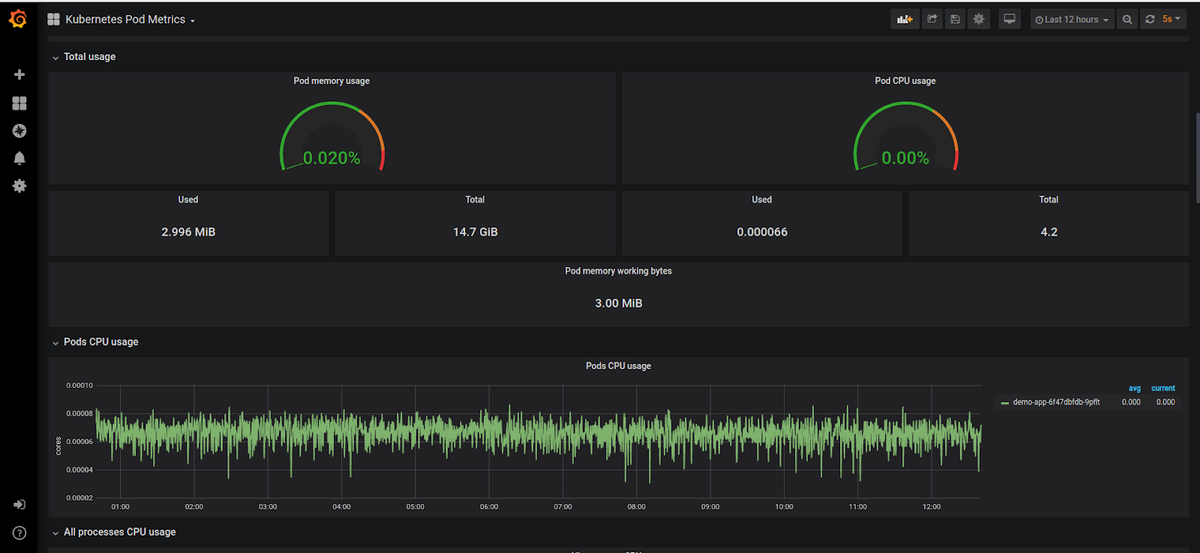Table of Contents
- Introduction
- Key Takeaways
- Various Monitoring Categories
- Infrastructure Monitoring
- System Metrics
- Kubernetes Metrics
- Kubernetes Container CPU and Memory Usage
- Kubernetes Pod CPU and Memory Usage
- Kubernetes Node CPU and Memory Usage
- Kubernetes Namespace CPU and Memory Usage
- Kubernetes Cluster CPU and Memory Usage
- Kubernetes Container CPU and Memory Requests
- Kubernetes Pod CPU and Memory Requests
- Kubernetes Node CPU and Memory Requests
- Kubernetes Namespace CPU and Memory Requests
- Kubernetes Cluster CPU and Memory Requests
- Kubernetes Container CPU and Memory Limits
- Kubernetes Pod CPU and Memory Limits
- Kubernetes Node CPU and Memory Limits
- Kubernetes Namespace CPU and Memory Limits
- Kubernetes Cluster CPU and Memory Limits
- Kubernetes Resource Capacity
- Kubernetes CPU and Memory Request Commitment (Resource Requests vs Capacity)
- Kubernetes CPU and Memory Limit Commitment (Resource Limits vs Capacity)
- Kubernetes Resource Utilization (Resource Usage vs Capacity)
- Kubernetes Resource Saturation
- Kube-State-Metrics Kubernetes Manifest
- Node-Exporter Metrics Kubernetes Manifest
- Application Performance Monitoring
- Setting up Kubernetes Monitoring using MetricFire
- Conclusion
Introduction
Monitoring is the most important aspect of infrastructure operations. Effective monitoring strategies help in optimizing infrastructure usage, better planning, and easy incident resolution.
While monitoring preceded DevOps, DevOps has further transformed the software development process to such an extent that monitoring has to evolve as well. The overall pace of software development has increased with DevOps and teams are now automating integration and testing, and deploying software in the cloud with quick timelines and continuous delivery.
With DevOps, there’s more to monitor now, from integration, and provisioning, to deployment, teams need to use DevOps monitoring strategies to effectively monitor different aspects of the project.
MetricFire specializes in monitoring systems and you can use our product with minimal configuration to gain in-depth insight into your environments. If you would like to learn more please book a demo with us, or sign up for a free trial today.
Today we will learn about some important monitoring strategies and concepts to help you gain a deeper understanding of your infra and applications.
Key Takeaways
- Monitoring is a critical aspect of infrastructure operations, and effective monitoring strategies are essential for optimizing infrastructure usage, better planning, and incident resolution.
- DevOps has transformed the software development process, leading to increased automation, cloud deployment, and continuous delivery, which necessitates the evolution of monitoring strategies.
- Kubernetes metrics play a significant role in monitoring containerized applications, including CPU and memory usage for containers, pods, nodes, namespaces, and clusters, as well as resource requests, limits, capacity, commitment, utilization, and saturation.
- Kubernetes metrics can be easily monitored with tools like Prometheus by deploying necessary components and creating dashboards.
- Application Performance Monitoring (APM) involves collecting and centralizing logs, tracing, and profiling to measure performance aspects like availability, error rates, throughput, user response time, and more.
Various Monitoring Categories
Determining what you should monitor in your applications. Monitoring targets can be divided into several primary categories, and you will likely want to cover at least one aspect of each category.
These categories include:
- Server Health
- Application Log Output
- Vulnerabilities
- Development Milestones
- User Activity
Infrastructure Monitoring
It is a key component of any application monitoring. It includes all the server metrics and with containers coming into the picture it should also include all the container-specific metrics. Some important metrics are:
System Metrics
- Availability
- CPU usage
- Disk usage
- Uptime
- Response time
- Databases
- Storage
- Components
- Virtual systems
- Performance
- User permissions
- Security
- Network switches
- Process level usage
- Throughput on the application
- Load of the servers
These metrics are fairly straightforward and much talked about already. Let’s deep dive a little bit into some Kubernetes Metrics.
Kubernetes Metrics
Kubernetes Container CPU and Memory Usage
Containers are the building blocks of containerized applications. Container CPU usage refers to the number of CPU resources consumed by containers in production. Memory usage is the measure of memory resources consumed. CPU resources are measured in CPU cores while memory is measured in bytes.
Kubernetes Pod CPU and Memory Usage
Pods are collections of containers and as such pod CPU usage is the sum of the CPU usage of all containers that belong to a pod. Similarly, pod memory usage is the total memory usage of all containers belonging to the pod.
Kubernetes Node CPU and Memory Usage
Node CPU usage is the number of CPU cores being used on the node by all pods running on that node. Similarly, node memory usage is the total memory usage of all pods.
Kubernetes Namespace CPU and Memory Usage
You can think of Kubernetes namespaces as boxes. DevOps can create separate boxes to isolate the resources belonging to individual applications or teams. Namespace resource usage is the sum of CPU or memory usage of all pods that belong to that namespace.
Kubernetes Cluster CPU and Memory Usage
The sum of CPU or memory usage of all pods running on nodes belonging to the cluster gives us the CPU or memory usage for the entire cluster.
Kubernetes Container CPU and Memory Requests
You can think of container resource requests as a soft limit on the amount of CPU or memory resources a container can consume in production.
Kubernetes Pod CPU and Memory Requests
The sum of CPU or memory requests of all containers belonging to a pod.
Kubernetes Node CPU and Memory Requests
Node CPU requests are a sum of the CPU requests for all pods running on that node. Similarly, node memory requests are a sum of memory requests of all pods.
Kubernetes Namespace CPU and Memory Requests
The sum of CPU or memory requests of all pods belonging to a namespace.
Kubernetes Cluster CPU and Memory Requests
Sum of CPU requests or memory requests for all pods running on nodes belonging to a cluster.
Kubernetes Container CPU and Memory Limits
Container CPU limits are a hard limit on the amount of CPU a container can consume in production. Memory limits are the maximum amount of bytes that a container can consume in production.
Kubernetes Pod CPU and Memory Limits
The sum of CPU or memory limits for all containers belonging to a pod.
Kubernetes Node CPU and Memory Limits
Node CPU limits are the sum of CPU limits for all pods running on that specific node. Node memory limits, on the other hand, are a sum of the memory limits of all pods.
Kubernetes Namespace CPU and Memory Limits
Sum of CPU or memory limits of all pods belonging to a namespace.
Kubernetes Cluster CPU and Memory Limits
Sum of CPU or memory limits for all pods running on nodes belonging to a cluster.
Kubernetes Resource Capacity
In cloud environments, Kubernetes nodes usually refer to cloud provider instances. Node CPU capacity is the total number of CPU cores on the node. Node memory capacity is the total number of bytes available on the node. For example, an N1-standard-1 instance has 2 vCPUs and 3.75 GB of memory.
Cluster CPU capacity is the sum of CPU capacities of all Kubernetes nodes that are part of the cluster. Cluster memory capacity is the sum of the memory capacities of all nodes belonging to the cluster. For example, a cluster with 4 N1-standard-1 instances has 8vCPUs and 15 GB of memory.
Kubernetes CPU and Memory Request Commitment (Resource Requests vs Capacity)
CPU request commitment is the ratio of CPU requests for all pods running on a node to the total CPU available on that node. In the same way, memory commitment is the ratio of pod memory requests to the total memory capacity of that node. We can also calculate cluster level request commitment by comparing CPU/memory requests on a cluster level to total cluster capacity.
Request commitments give us an idea of how much of the node or cluster is committed in terms of soft resource usage limits.
Kubernetes CPU and Memory Limit Commitment (Resource Limits vs Capacity)
CPU limit commitment is the ratio of CPU limits for all pods running on a node to the total CPU available on that node. Similarly, memory commitment is the ratio of pod memory limits to the total memory capacity of that node. Cluster level limit commitments can be calculated by comparing total CPU/memory limits to cluster capacity.
Limit commitments give us an idea of how much of the node or cluster is committed in terms of hard CPU and memory limits.
Kubernetes Resource Utilization (Resource Usage vs Capacity)
With the emphasis on pay-as-you-go billing models for cloud deployments, resource utilization is an important metric to monitor and has major implications for cost control.
CPU utilization is the ratio of CPU resources being currently consumed by all pods running on a node to the total CPU available on that node. Memory utilization is the ratio of memory usage by all pods to the total memory capacity of that node.
Cluster resource utilization will compare resource usage (both CPU and memory) for all pods with the total resource capacity of all nodes.
Kubernetes Resource Saturation
Node CPU saturation is the measure of requests for CPU which cannot be fulfilled because of unavailability. Similarly, memory saturation on the node is a measure of the memory requests which cannot be met due to unavailability.
Saturation on the cluster level can be calculated based on saturation numbers across all nodes.
These metrics might seem overwhelming but it is extremely easy to scrape and monitor them with Prometheus. If you have a Prometheus instance running all you need to do is:
- Deploy Kube-state metrics for container and pod metrics. (manifest is given below)
- Deploy Node-exporter for system-level metrics. (manifest is given below)
Kube-State-Metrics Kubernetes Manifest
apiVersion: v1
kind: Namespace
metadata:
name: monitoring
---
apiVersion: rbac.authorization.k8s.io/v1
# kubernetes versions before 1.8.0 should use rbac.authorization.k8s.io/v1beta1
kind: ClusterRoleBinding
metadata:
name: kube-state-metrics
roleRef:
apiGroup: rbac.authorization.k8s.io
kind: ClusterRole
name: kube-state-metrics
subjects:
- kind: ServiceAccount
name: kube-state-metrics
namespace: monitoring
---
apiVersion: rbac.authorization.k8s.io/v1
# kubernetes versions before 1.8.0 should use rbac.authorization.k8s.io/v1beta1
kind: ClusterRole
metadata:
name: kube-state-metrics
rules:
- apiGroups: [""]
resources:
- configmaps
- secrets
- nodes
- pods
- services
- resourcequotas
- replicationcontrollers
- limitranges
- persistentvolumeclaims
- persistentvolumes
- namespaces
- endpoints
verbs: ["list", "watch"]
- apiGroups: ["extensions"]
resources:
- daemonsets
- deployments
- replicasets
verbs: ["list", "watch"]
- apiGroups: ["apps"]
resources:
- statefulsets
verbs: ["list", "watch"]
- apiGroups: ["batch"]
resources:
- cronjobs
- jobs
verbs: ["list", "watch"]
- apiGroups: ["autoscaling"]
resources:
- horizontalpodautoscalers
verbs: ["list", "watch"]
---
apiVersion: rbac.authorization.k8s.io/v1
# kubernetes versions before 1.8.0 should use rbac.authorization.k8s.io/v1beta1
kind: RoleBinding
metadata:
name: kube-state-metrics
namespace: monitoring
roleRef:
apiGroup: rbac.authorization.k8s.io
kind: Role
name: kube-state-metrics-resizer
subjects:
- kind: ServiceAccount
name: kube-state-metrics
namespace: monitoring
---
apiVersion: rbac.authorization.k8s.io/v1
# kubernetes versions before 1.8.0 should use rbac.authorization.k8s.io/v1beta1
kind: Role
metadata:
namespace: monitoring
name: kube-state-metrics-resizer
rules:
- apiGroups: [""]
resources:
- pods
verbs: ["get"]
- apiGroups: ["extensions"]
resources:
- deployments
resourceNames: ["kube-state-metrics"]
verbs: ["get", "update"]
---
apiVersion: v1
kind: ServiceAccount
metadata:
name: kube-state-metrics
namespace: monitoring
---
apiVersion: apps/v1
kind: Deployment
metadata:
name: kube-state-metrics
namespace: monitoring
spec:
selector:
matchLabels:
k8s-app: kube-state-metrics
replicas: 1
template:
metadata:
labels:
k8s-app: kube-state-metrics
spec:
serviceAccountName: kube-state-metrics
containers:
- name: kube-state-metrics
image: quay.io/mxinden/kube-state-metrics:v1.4.0-gzip.3
ports:
- name: http-metrics
containerPort: 8080
- name: telemetry
containerPort: 8081
readinessProbe:
httpGet:
path: /healthz
port: 8080
initialDelaySeconds: 5
timeoutSeconds: 5
- name: addon-resizer
image: k8s.gcr.io/addon-resizer:1.8.3
resources:
limits:
cpu: 150m
memory: 50Mi
requests:
cpu: 150m
memory: 50Mi
env:
- name: MY_POD_NAME
valueFrom:
fieldRef:
fieldPath: metadata.name
- name: MY_POD_NAMESPACE
valueFrom:
fieldRef:
fieldPath: metadata.namespace
command:
- /pod_nanny
- --container=kube-state-metrics
- --cpu=100m
- --extra-cpu=1m
- --memory=100Mi
- --extra-memory=2Mi
- --threshold=5
- --deployment=kube-state-metrics
---
apiVersion: v1
kind: Service
metadata:
name: kube-state-metrics
namespace: monitoring
labels:
k8s-app: kube-state-metrics
annotations:
prometheus.io/scrape: 'true'
spec:
ports:
- name: http-metrics
port: 8080
targetPort: http-metrics
protocol: TCP
- name: telemetry
port: 8081
targetPort: telemetry
protocol: TCP
selector:
k8s-app: kube-state-metrics
Node-Exporter Metrics Kubernetes Manifest
apiVersion: extensions/v1beta1
kind: DaemonSet
metadata:
name: node-exporter
namespace: monitoring
labels:
name: node-exporter
spec:
template:
metadata:
labels:
name: node-exporter
annotations:
prometheus.io/scrape: "true"
prometheus.io/port: "9100"
spec:
hostPID: true
hostIPC: true
hostNetwork: true
containers:
- name: node-exporter
image: prom/node-exporter:v0.16.0
securityContext:
privileged: true
args:
- --path.procfs=/host/proc
- --path.sysfs=/host/sys
ports:
- containerPort: 9100
protocol: TCP
resources:
limits:
cpu: 100m
memory: 100Mi
requests:
cpu: 10m
memory: 100Mi
volumeMounts:
- name: dev
mountPath: /host/dev
- name: proc
mountPath: /host/proc
- name: sys
mountPath: /host/sys
- name: rootfs
mountPath: /rootfs
volumes:
- name: proc
hostPath:
path: /proc
- name: dev
hostPath:
path: /dev
- name: sys
hostPath:
path: /sys
- name: rootfs
hostPath:
path: /
Once you have deployed these, you can chart your metrics and create dashboards.
Application Performance Monitoring
Application performance monitoring is where logs are searched, collected, and centralized with tracing and profiling available on the application.
It also helps provide measurements on performance such as availability, error rate, throughput, user response time, slow pages, page loads, third-party JavaScript slowness, track SLAs, browser speed, and checks for end-user transactions.
While this list is not exhaustive by any means, it should give you an idea of what your existing monitoring tools offer and what are the loopholes in your DevOps monitoring strategy.
Setting up Kubernetes Monitoring using MetricFire
To handle a production-level Kubernetes infrastructure can require a few hundred nodes and upwards of a few Mbps network traffic. Meaning you would need to scale out both Graphite and Grafana to handle the increasing load.
That’s where Hosted Graphite and Hosted Grafana come into the picture. It allows you to scale for long-term storage, as well as provides redundant storage of data without you having to go through the arduous process of setting up Graphite and Grafana.
Hosted Graphite and Hosted Grafana through MetricFire allow for the continuous active deployment of new features, as MetricFire’s products all have their foundations in the ever-growing open source projects. Configuring a Snap Daemon to send Kubernetes metrics to your MetricFire account is simple and just requires configuring your account's API key to be used as the prefix for each metric and the URL Endpoint to be used as the server destination. Check out our article Monitoring Kubernetes with Hosted Graphite to learn how to set up monitoring your Kubernetes infrastructure quickly and easily using our Hosted service.
Sign up for the MetricFire free trial here, and start building Kubernetes dashboards within a few minutes.
Conclusion
This blog should provide you with some insight into what metrics to monitor in your ecosystem. Additionally, you can also expose custom metrics and Metricfire can help you scrape them and plot-relevant dashboards. All in a few clicks :)
If you need help setting up these metrics feel free to reach out to me through LinkedIn. Additionally, MetricFire can help you monitor your applications across various environments. Monitoring is extremely essential for any application stack, and you can get started with your monitoring using MetricFire’s free trial.
Robust monitoring will not only help you meet SLAs for your application but also ensure a sound sleep for the operations and development teams. If you would like to learn more please book a demo with us.





